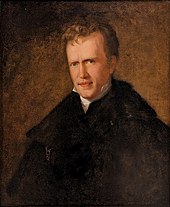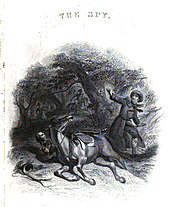In literary criticism, stream of consciousness is a narrative mode or method that attempts "to depict the multitudinous thoughts and feelings which pass through the mind" of a narrator.

William Blackwood was a Scottish publisher who founded the firm of William Blackwood and Sons.

Brother Jonathan is the personification of New England. He was also used as an emblem of the United States in general, and can be an allegory of capitalism. His too-short pants, too-tight waistcoat and old-fashioned style reflect his taste for inexpensive, second-hand products and efficient use of means.

William Pinkney was an American statesman and diplomat, and was appointed the seventh U.S. Attorney General by President James Madison.

Samuel Parris was the Puritan minister in Salem Village, Massachusetts, during the Salem witch trials. He was also the father of one of the afflicted girls, and the uncle of another.

John Neal was an American writer, critic, editor, lecturer, and activist. Considered both eccentric and influential, he delivered speeches and published essays, novels, poems, and short stories between the 1810s and 1870s in the United States and Great Britain, championing American literary nationalism and regionalism in their earliest stages. Neal advanced the development of American art, fought for women's rights, advocated the end of slavery and racial prejudice, and helped establish the American gymnastics movement.

John Pierpont was an American poet, who was also successively a teacher, lawyer, merchant, and Unitarian minister. His poem The Airs of Palestine made him one of the best-known poets in the U.S. in his day. He was the grandfather of J. P. Morgan.

Blackwood's Magazine was a British magazine and miscellany printed between 1817 and 1980. It was founded by the publisher William Blackwood and was originally called the Edinburgh Monthly Magazine. The first number appeared in April 1817 under the editorship of Thomas Pringle and James Cleghorn. The journal was unsuccessful and Blackwood fired Pringle and Cleghorn and relaunched the journal as Blackwood's Edinburgh Magazine under his own editorship. The journal eventually adopted the shorter name and from the relaunch often referred to itself as Maga. The title page bore the image of George Buchanan, a 16th-century Scottish historian, religious and political thinker.

Edward Coote Pinkney was an American poet, lawyer, sailor, professor, and editor. Born in London in 1802 when his father was serving as ambassador to the Court of St. James, Pinkney returned with his family to the United States when he was eight. They returned to Maryland, where he was privately schooled.
Brother Jonathan was a weekly publication operated by Benjamin Day from 1842 to 1862, and was the first weekly illustrated publication in the United States.

William Blackwood and Sons was a Scottish publishing house and printer founded by William Blackwood in 1804. It played a key role in literary history, publishing many important authors, for example John Buchan, George Tomkyns Chesney, Joseph Conrad, George Eliot, E. M. Forster, John Galt, John Neal, Thomas De Quincey, Charles Reade, Margaret Oliphant, John Hanning Speke and Anthony Trollope, both in books and in the monthly Blackwood’s Magazine.

The bibliography of American writer John Neal (1793–1876) spans more than sixty years from the War of 1812 through Reconstruction and includes novels, short stories, poetry, articles, plays, lectures, and translations published in newspapers, magazines, literary journals, gift books, pamphlets, and books. Favorite topics included women's rights, feminism, gender, race, slavery, children, education, law, politics, art, architecture, literature, drama, religion, gymnastics, civics, American history, science, phrenology, travel, language, political economy, and temperance.

Articles by American writer John Neal (1793–1876) influenced the development of American literature towards cultural independence and a unique style. They were published in newspapers, magazines, and literary journals and are part of his bibliography. They include his first known published work and pieces published in the last decade of his life. The topics of these works reflect the Neal's broad interests, including women's rights, feminism, gender, race, slavery, children, education, law, politics, art, architecture, literature, drama, religion, gymnastics, civics, American history, science, phrenology, travel, language, political economy, and temperance.
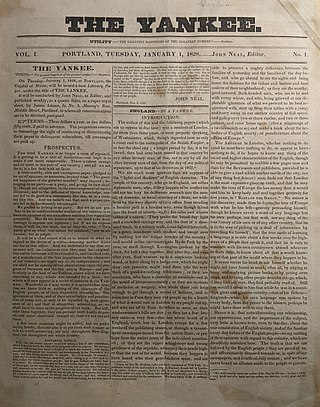
The Yankee was one of the first cultural publications in the United States, founded and edited by John Neal (1793–1876), and published in Portland, Maine as a weekly periodical and later converted to a longer, monthly format. Its two-year run concluded at the end of 1829. The magazine is considered unique for its independent journalism at the time.
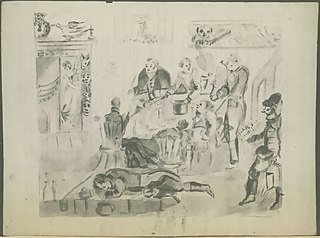
The Delphian Club was an early American literary club active between 1816 and 1825. The focal point of Baltimore's literary community, Delphians like John Neal were prodigious authors and editors. The group of mostly lawyers and doctors gathered weekly to share refreshments and facetious stories, with many of their works being published in The Portico magazine. The club's structure and terminology were inspired by classical antiquity and comical verbosity. Sixteen men claimed membership over the club's nine-year run, with no more than nine serving at a time. Edgar Allan Poe satirized the group in his unpublished Tales of the Folio Club in the 1830s.

Rachel Dyer: A North American Story is a Gothic historical novel by American writer John Neal. Published in 1828 in Maine, it is the first bound novel about the Salem witch trials. Though it garnered little critical notice in its day, it influenced works by Nathaniel Hawthorne, Henry Wadsworth Longfellow, John Greenleaf Whittier, and Walt Whitman. It is best remembered for the American literary nationalist essay, "Unpublished Preface", that precedes the body of the novel.

Logan, a Family History is a Gothic novel of historical fiction by American writer John Neal. Published anonymously in Baltimore in 1822, the book is loosely inspired by the true story of Mingo leader Logan the Orator, while weaving a highly fictionalized story of interactions between Anglo-American colonists and Indigenous peoples on the western frontier of colonial Virginia. Set just before the Revolutionary War, it depicts the genocide of Native Americans as the heart of the American story and follows a long cast of characters connected to each other in a complex web of overlapping love interests, family relations, rape, and sexual activity.
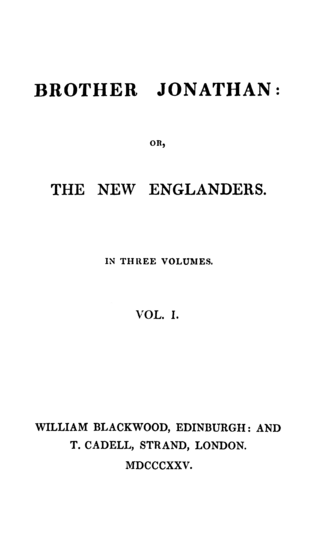
Brother Jonathan: or, the New Englanders is an 1825 historical novel by American writer John Neal. The title refers to Brother Jonathan, a popular personification of New England and the broader United States. The story follows protagonist Walter Harwood as he and the nation around him both come of age through the American Revolution. The novel explores cross-cultural relationships and highlights cultural diversity within the Thirteen Colonies, stressing egalitarianism and challenging the conception of a unified American nation. It features mixed-race Anglo-Indigenous characters and depicts them as the inheritors of North America. The book's sexual themes drew negative reactions from contemporary critics. These themes were explicit for the period, addressing female sexual virtue and male guilt for sexual misdeeds.


